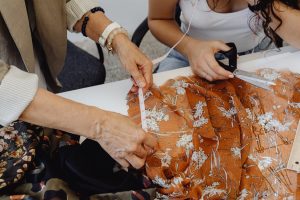Kimonos have become increasingly popular in recent years. Their elegant designs and intricate details capture the hearts of many. However, those interested in purchasing these traditional garments may find themselves facing a surprising challenge: rising prices. In this blog post, we’ll explore a few root causes of this phenomenon. These include inflation in the fashion industry, a shortage of qualified sewers, and increased demand for quality products. We’ll also discuss why now may be the best time to invest in a good-quality kimono.
One of the primary factors contributing to the rising cost of kimonos is inflation in the fashion industry. Raw material prices, fuel costs, packaging expenses, and labor wages have all gone up. This directly impacts the final prices of the products. Moreover, the COVID-19 pandemic and subsequent restrictions steered many senior sewers in Japan to retire. This created a shortage of tenured workers. Coupled with the consolidation of fabric manufacturers, this has driven up demand and prices for those facilities that remain open.
As a result, the supply of quality kimonos has dwindled, leading to increased demand and higher prices. Customers who want an authentic, well-crafted kimono can reach out to a qualified dealer in the United States. This is where the expression “you get what you pay for” comes in. Cheaper options from other countries like China, Myanmar and other regions may use slave labor or underpay their workers. Fabrics may not wear well and the quality of the finished product often leaves customers disappointed. If you want a quality kimono, now may be a good time time to buy, before prices rise even higher.
Another factor affecting the cost of kimonos is the increased demand for the product. In recent years, kimonos have become more popular. Outside of Japan, more people are embracing the elegant, traditional style. This has led to more demand pressure on limited supplies, driving up prices even further. When demand outstrips supply, the market adjusts accordingly, and this is exactly what’s happening in the kimono industry.
Furthermore, kimonos have moved beyond being just a traditional garment and have become a fashion statement. Many designers and brands have started creating their own version of kimonos, which can cost much more than traditional versions. These luxury kimono designs feature intricate embroidery, beading, and other embellishments, driving up the cost of production and retail price. But just labeling them as luxury doesn’t always mean quality. There is one company in San Francisco that buys a lot of advertising and portrays luxurious Japanese kimonos, when in fact they manufacture them in China.
In conclusion, the rising cost of kimonos is due to a complex mix of inflation, shortage of qualified sewers, limited supplies, increased demand, and luxury branding. Although this may be disappointing news for those who want a quality kimono, it also presents a unique opportunity. Investing in a high-quality, authentic kimono now while prices are still somewhat reasonable. Take advantage of this opportunity before prices rise even further, and enjoy the beauty and elegance that kimonos bring to your wardrobe.
A USA-based Kimono Source, www.chopa.com has been in business since 1994 and specializes in authentic Japanese Kimono and yukata at reasonable prices. Their online Kimono Shop offers hundreds of styles, colors and patterns in many sizes. As a direct importer, they ship quickly from the USA, saving you the hassle of customs, expensive shipping and long waits for your order. They are true professionals.
Tags: Buy Kimonos, Kimono Shop, kimono yukata, USA kimono








